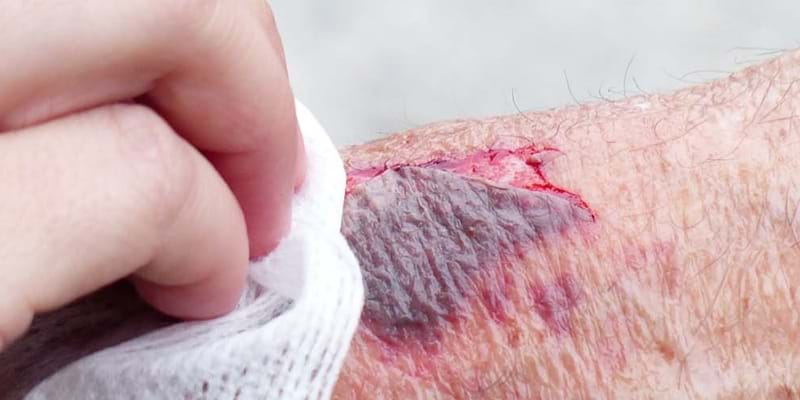
Transfer without tissue damage
A recent study from the University of Ghent in Belgium, shows no correlation between the development of pressure ulcers and the use of VENDLET V5S. Using VENDLET V5S for repositioning is on the contrary associated with maintaining the clients skin integrity better than manual methods.The study also showed that using VENDLET V5S resulted in fewer reports of work-related musculoskeletal disorders (MSDs) and also increased staff efficiency.
9. August 2016
Manual transfers associated with pressure ulcers
Regular, individualized repositioning is recognized as being efficient in the prevention of pressure ulcers, and repositioning is very important for both the comfort and wellbeing of clients that spend a significant amount of time in bed. However, repositioning is often also associated with having negative effects on patients’ health, such as the development of pressure ulcers through shearing.
And this has previously been confirmed in the study “Guidelines, Classification and Cross-over Research in order to Save Nurses Backs and Patients Skin” (2014), which was conducted by the Dutch researchers Nico Knibbe and Hanneke Knibbe. This is due to shearing. Not friction between the bedridden client and the slidesheet, but due to displacements/shearing and stretching inside the skin and the underlying tissue layers.
It is based on these findings that this new study from the University of Ghent has been performed in order to explore further if these results are also true for mechanic transfers.
New study explores VENDLET
Besides the challenge of shearing, the study from Ghent also explored how transfers physically influences the caregivers. Manual repositioning and transfers can be straining and very time consuming for staff. It is also one of the main reasons for development of MSDs, and the subsequent work injuries and sick days.
As such, the study specifically focused on the correlation between using an electrical repositioning system, the VENDLET V5S, and
- the prevention of skin problems and
- reduction of physical strain on caregivers.
The study, which took place over the course of 4 weeks, was conducted at two Belgian nursing homes on 13 bedridden patients and 35 caregivers consisting of 16 nurses and 19 healthcare assistants. The 13 clients risk of developing pressure ulcers was evaluated by use of the Braden Scale. They were ranked from 12 to 19 on the scale. All employees were specifically trained in the use of the VENDLET system before starting the test period.
VENDLET not Associated with Skin Issues
The results of the study showed that using the VENDLET V5S was not associated with neither the development nor the exacerbation of pressure ulcers, and four out of seven pressure ulcers even healed during the four weeks of using the VENDLET system.
As such, the study underlines that there is no reason to assume a correlation between mechanical repositioning and the development of pressure ulcers through shear forces, which has otherwise been shown to be the case when using manual positioning methods and devices such as slide sheets.
The study also suggests that repositioning routines, mechanical or manual, cannot reduce pressure ulcer incidents alone, but must be combined with other preventative measures
Unambiguous Reduction in MSD's
As several other studies have previously shown, caregivers in the Belgian nursing homes also perceived that they had fewer musculoskeletal symptoms during repositioning with VENDLET V5S compared to manual methods. This is explained by the repositioning being nearly effortless with the automated repositioning system.
The study also showed that staff efficiency at the two nursing homes increased with the use of VENDLET V5S, as patients can be safely cared for by one caregiver instead of two, which was otherwise common practice. Thereby, more time was freed for other important caregiving tasks.
Overall, the study showed that caregivers’ work health & safety was improved by reducing the MSDs, but also that the mechanical repositioning system is not at risk of increasing the number of skin issues for patients.
Background
The study is the master thesis of Elien Zwaenepoel, Ghent University, Faculty of Medicine and Health Sciences. Eliens thesis has the title: ”The feasibility of repositioning patients with an automatic turning system in the prevention of pressure ulcer”.
The thesis has been conducted under the management and councelling of professor dr. Dimitri Beeckman from the University of Ghent, Faculty of Medicine and Health Sciences. Dimitri Beeckman is a professor of skin integrity and clinical care.
Nico Knibbe from the Dutch LOCOmotion Research has taken part in outlining and evaluating the study. LOCOmotion is a world known leading expert within ergonomics in the healthcare sector.
Publication
British Journal of Nursing published an article about the study in March 2018 under the headline: ”An automatic repositioning system to prevent pressure ulcers: a case series”.
Authors of the article:
Elien Zwaenepoel, Researcher Skin lntegrity and Clinical Nursing, Ghent University, Belgium
Dimitri Beeckman, Professor of Skin lntegrity and Clinical Nursing, Ghent University, Belgium
Nico E Knibbe, Researcher, LOCOmotion Research, Bennekorn, Holland
Hanneke JJ Knibbe, Researcher, LOCOmotion Research, Bennekorn, Holland
Accepted for publication: February 2018
Download PDF:
Zwaenepoel, 2017: The feasibility of repositioning patients with an automatic turning system in the prevention of pressure ulcer
Knibbe et al, 2018: An automatic repositioning system to prevent pressure ulcers: a case series
Knibbe et al, 2014: Prevention of Pressure Ulcers: Exploring the Influence of Nurses, Equipment and Working Techniques
